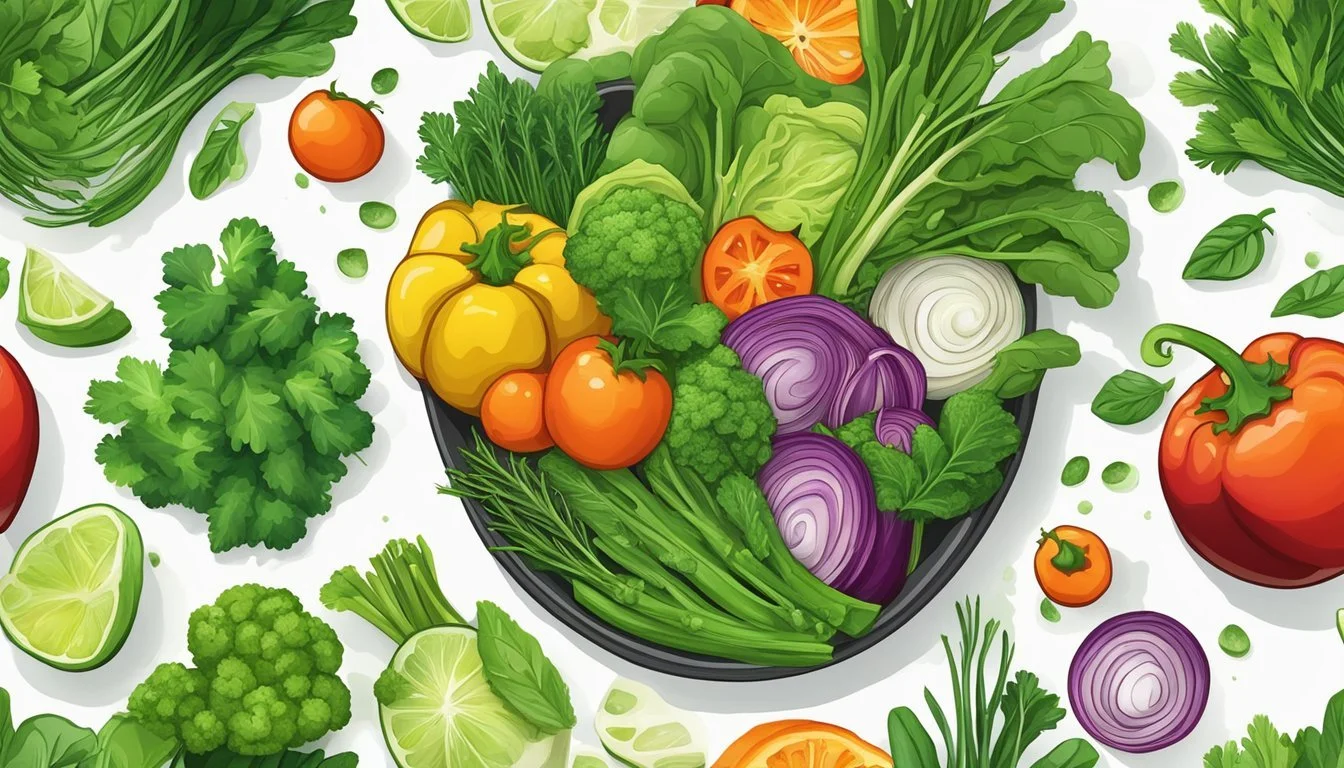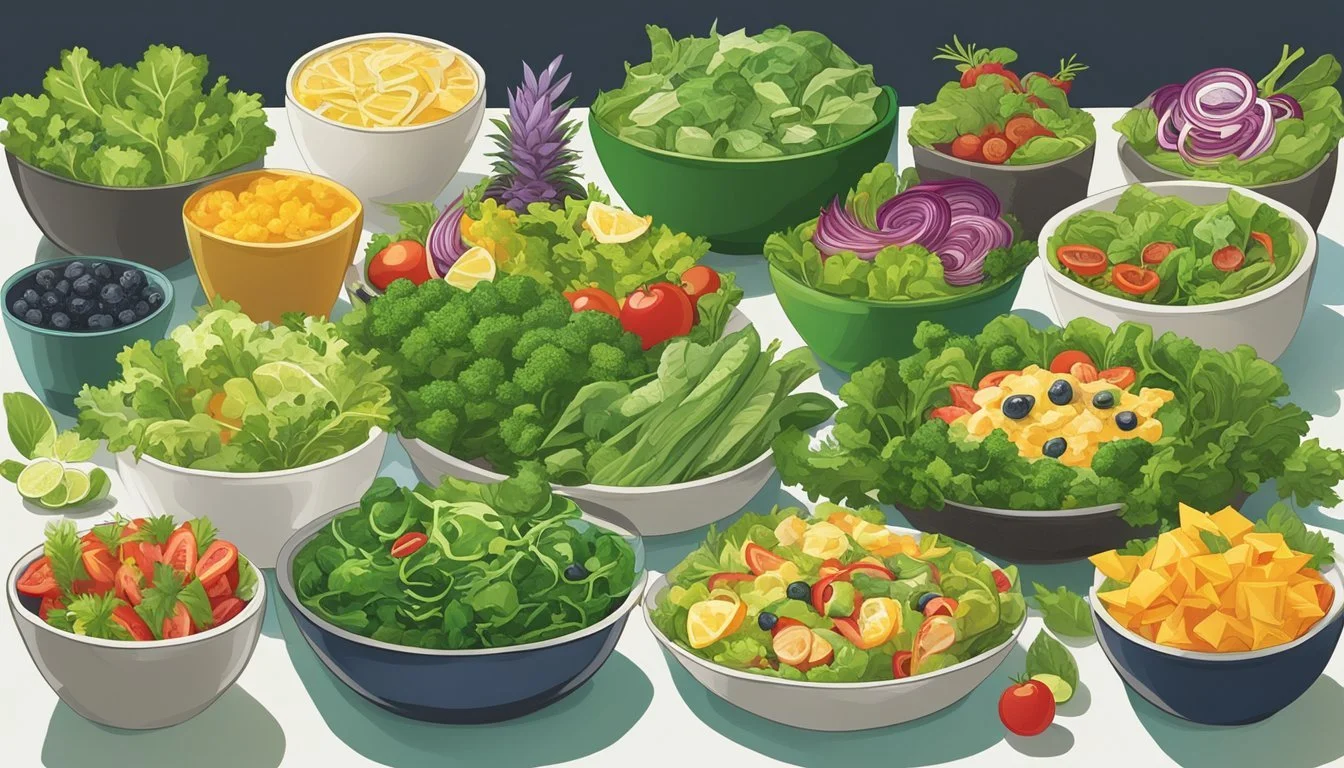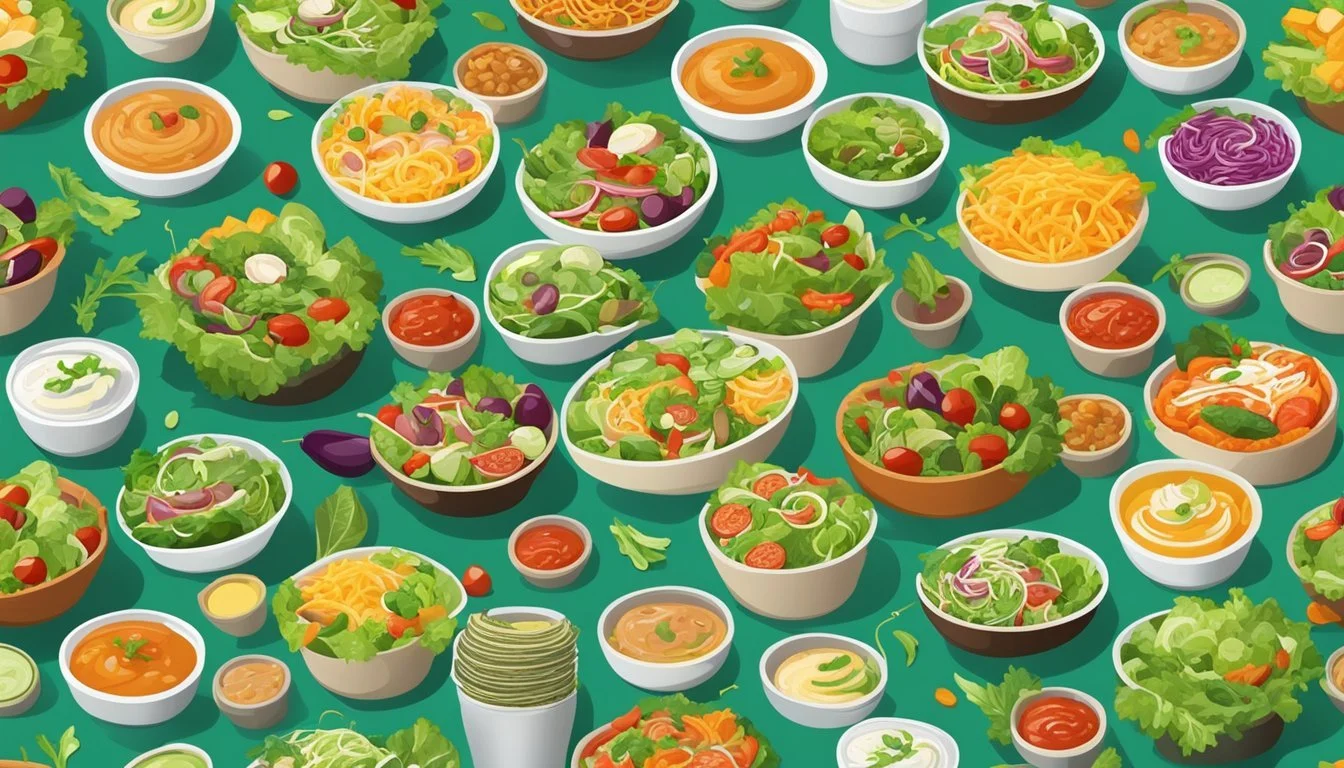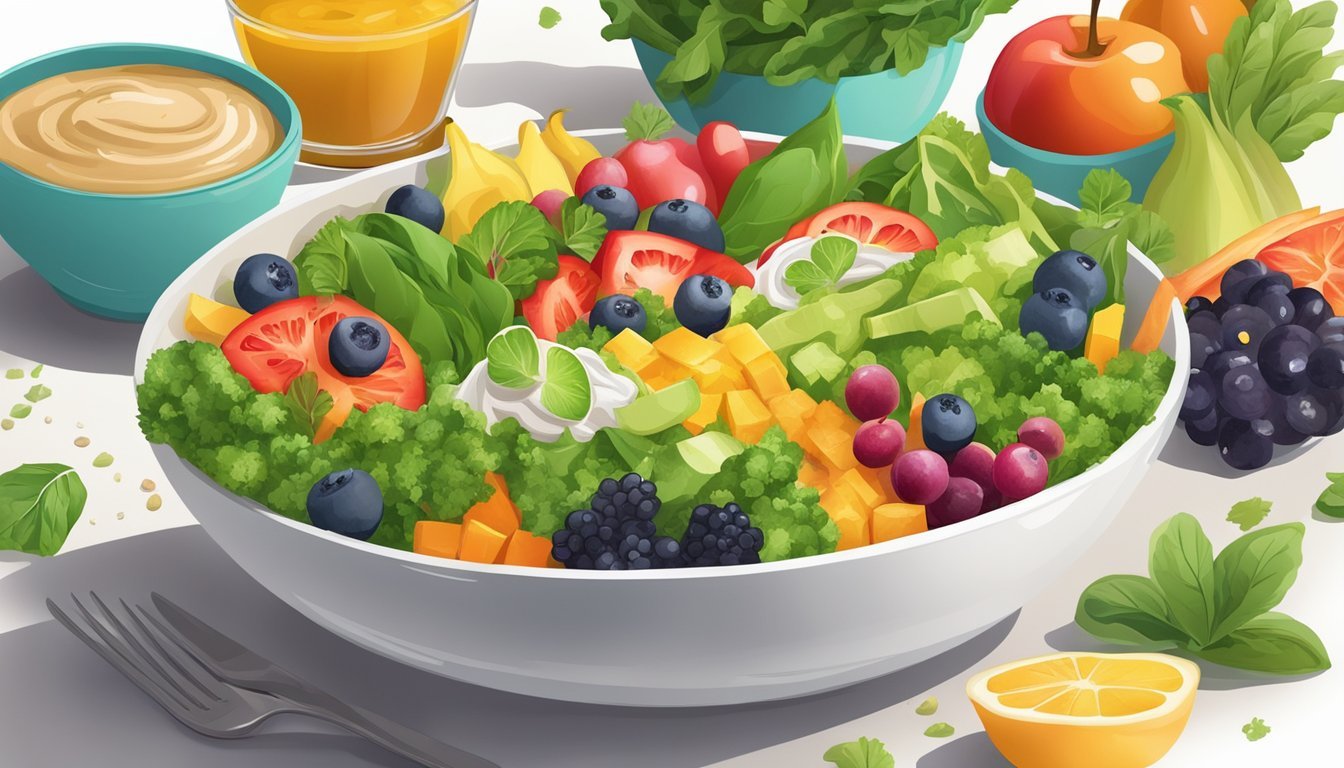Swicy Salads
Spicing Up Your Greens with Bold Flavors
Salads (What wine goes well with salads?) are a staple in many healthy diets, often prized for their freshness and nutritional value. They provide a versatile canvas for a variety of ingredients, from tender leafy greens to hearty vegetables. However, an emerging trend in the salad world is the introduction of a "swicy" element—that is, a combination of sweet and spicy flavors. This trend caters to the growing consumer desire for meals that are not only healthy but also packed with bold and exciting flavors.
Integrating spicy elements into salads can transform a simple dish into a vibrant culinary experience. Ingredients like peppery arugula, watercress, and mustard greens have gained popularity for their inherent zest, while the addition of spicy microgreens offers a burst of heat that complements the natural sweetness found in many vegetables and dressings. These spicy elements are more than a mere garnish; they infuse salads with a unique flavor profile and awaken the palate.
Incorporating proteins into these spicy salads offers a nutritional boost, making them a well-rounded meal option. Simple additions such as sliced almonds, pumpkin seeds, sunflower seeds, or beans not only contribute texture but also increase the protein content, ensuring that the salad satisfies both taste and dietary requirements. The presence of a protein component supports muscle repair and provides longer-lasting energy, making spicy salads a wholesome choice for those looking to fuel their bodies without compromising on taste.
The Basics of Building a Salad
When it comes to crafting a salad, the foundation lies in selecting the right leafy greens. The variety of lettuces available, from romaine to arugula, offer a broad canvas upon which to build. Each type of green brings a different nutritional profile to the table; for example, spinach (What wine goes well with spinach?) is rich in iron and calcium, while romaine lettuce is a good source of vitamin A and fiber.
Ingredients are what transform a simple bowl of greens into a complex dish. Including a mixture of colorful vegetables not only enhances the visual appeal but also boosts the nutritional value. A well-composed salad balances textures and flavors among its components:
Crunchiness can come from sliced cucumbers or bell peppers.
Sweetness might be introduced with cherry tomatoes (What wine goes well with tomatoes?) or carrots.
Fiber is provided by adding beans or seeds.
When incorporating salad greens into a meal, it's essential to ensure they're properly prepared:
Greens should be washed to remove any dirt or residual pesticides.
Drying the greens is crucial to prevent a watered-down dressing.
Here's a quick reference guide for salad assembly:
Step Action 1. Base Choose a variety of leafy greens for vitamins and fiber. 2. Color Add colorful vegetables for a nutritional and visual boost. 3. Texture Incorporate ingredients like nuts or croutons for crunch. 4. Protein Include a protein source to convert salad into a hearty meal.
By understanding these basics, anyone can elevate their salad game, creating meals that are as nutritious as they are delicious.
Flavor Profiles and Dressing
When crafting a salad, the dressing is essential in defining its flavor profile. Vinaigrettes and creamy dressings are versatile options, offering distinct sensory experiences. Vinaigrettes, typically made with olive oil, an acid like vinegar or citrus juice, and seasonings, impart a light and tangy note to greens. The choice of oil and acid can significantly influence the dressing's character, with olive oil being a popular choice for its fruity notes.
Creamy dressings, on the other hand, offer a richer taste and texture. Ingredients like mayonnaise, yogurt, or pureed avocado are common bases, which when combined with herbs and spices, result in a lusciously smooth coating for the salad components.
Below is a table detailing flavor combinations that enhance dressings:
Base Type Herbs Add-Ins Vinaigrette Basil, Parsley, Mint Garlic, Mustard Creamy Dill, Chives Parmesan, Anchovies (What wine goes well with anchovies?)
Incorporating herbs can dramatically transform the flavor of a dressing. For a peppery zest, fresh basil or mint can be finely chopped and whisked into vinaigrettes. Parsley offers a fresh, clean taste whereas garlic adds depth and piquancy.
Successful flavor combinations often balance the four taste profiles: sweet, sour, salty, and bitter. For example, pairing olive oil (bitter and fruity) with lemon juice (sour) and honey (sweet) creates a well-rounded vinaigrette. When making a creamy dressing, one might blend the tang of yogurt with the gentle heat of peppery spices to complement the salad's ingredients.
Selecting the right dressing can elevate the salad from a mere side dish to a culinary delight, as it harmonizes the flavors and textures of the ingredients.
Salad Varieties and Recipes
In this section, readers will find a selection of salad ideas that are designed to enhance their dining experience, whether it be through nutrient-rich green salads, protein-packed mixes, or versatile salads fit for any meal of the day.
Green Leafy Salad Ideas
Leafy greens serve as foundational elements for salads, presenting an assortment of flavors and nutritional benefits. Incorporate kale, spinach, and arugula to construct a base that's as vibrant in color as it is in vitamins and minerals. Spicy radish microgreens can add a peppery note, while cabbage, iceberg, and romaine lettuce offer a more delicate and crunchy texture.
Kale Caesar Salad: Massage torn kale leaves with a homemade Caesar dressing and add croutons and shaved Parmesan cheese for a twist on this classic dish.
Spinach and Microgreens Mix: Pair tender spinach with a zesty variety of microgreens, like radish or mustard, and toss them with a light vinaigrette for a refreshing salad.
Protein-Enriched Salad Combinations
Adding proteins such as chicken, beans, nuts, salmon, and turkey to salads can transform them from a simple side into a substantial main course. Here are some recipes that marry greens and proteins harmoniously:
Chicken Taco Salad:
Ingredients Quantity Cooked chicken, shredded 1 cup Black beans, rinsed 1/2 cup Corn kernels 1/2 cup Romaine lettuce, chopped 2 cups Avocado, diced 1/2 Tortilla strips 1/4 cup Mix these ingredients and top with a lime-cilantro dressing.
Salmon Spinach Salad:
Ingredients Quantity Fresh spinach 2 cups Grilled salmon 5 ounces Sliced almonds 2 tbsp Cherry tomatoes 1/2 cup Drizzle with a lemon-dill vinaigrette to enhance the flavors.
Salads for Different Meals
Salads are no longer confined just to lunch (What wine goes well with lunch?); they can also be the centerpiece of dinner (What wine goes well with dinner?) or played down as a side dish. Diverse in nature, salads can tackle the form of a taco salad, complement a cozy bowl of soup, or garnish a colorful stir-fry. Incorporating a variety of ingredients from meats to beans can elevate a simple green salad to a fulfilling dinner option, while lighter, simpler combinations are perfect for a midday lunch boost. Salads can also be deconstructed into other meal elements such as sandwich spreads or taco fillings.
Lunch Sandwich with Microgreen Mix: Use a mix of microgreens with sliced turkey and Swiss cheese to create a sandwich that's high in nutrients and taste.
Dinner Stir-Fry with Salad: Pair a vegetable stir-fry (What Wine Pairs Perfectly With Vegetable Stir-Fry?) with a side salad composed of iceberg lettuce, shredded carrots, and bean sprouts drizzled with a light soy dressing.
Ingredient Selection and Preparation
Selecting top-quality ingredients and employing proper preparation techniques are pivotal for creating a Swicy Salad that tingles the taste buds. Freshness and proper handling can elevate the simplest of greens to a flavorful experience.
Choosing Fresh Ingredients
When picking ingredients for Swicy Salads, one must prioritize freshness to ensure a burst of natural flavor and crisp texture. Cucumbers and tomatoes, two salad staples, should have a firm skin and be free from blemishes or soft spots. The presence of bright colors and a lack of wilting indicate high-quality veggies overall. For onions, a staple for zing, one should look for a crisp, dry outer layer and avoid onions that have a strong smell or sprouts, as these can be signs of age.
Cucumbers: Look for bright green color, firmness.
Tomatoes: Choose bright, richly colored skins and a slight give on pressure.
Onions: Opt for bulbs with dry, papery skin; no sprouting.
Freshness Scale:
Vegetable Indicator of Freshness Cucumbers Firm to touch, no soft spots Tomatoes Bright color, slight yield on pressure Onions No sprouts, dry outer skin
Preparation Techniques
Proper preparation of ingredients is just as crucial as the selection process. Washing all veggies thoroughly removes any residual dirt and potential contaminants. For leafy greens, a salad spinner is a valuable tool to dry them after washing, which helps dressing to adhere to the leaves. When it comes to chopping, uniform sizes allow for even flavor distribution and a more palatable texture. Ingredients like tomatoes should be sliced just before serving to retain their juices and structure.
Washing: Soak and rinse under running water; use salad spinner for greens.
Chopping: Consistent sizes; tomatoes and cucumbers sliced, onions finely diced.
Chop Size Guide:
Vegetable Chop Style Cucumbers ¼ inch slices Tomatoes Half-moon slices Onions Fine dice
Essential to any salad, but especially for Swicy Salads, is the blending of texture and flavor through well-chosen, fresh ingredients and careful preparation.
Health and Nutritional Benefits
When incorporating spicy salad mixes into a diet, one can expect a diverse range of health and nutritional benefits. These greens not only introduce a vivid flavor palette but also contribute significantly to wellness and nutrition.
Essential Vitamins and Minerals
Vitamin A: This is essential for maintaining healthy vision and skin. Dark or red leafy greens, such as those found in some spicy salad mixes, are particularly rich in this vitamin.
Vitamin C: It plays a pivotal role in the maintenance of the immune system and acts as a powerful antioxidant. Salads containing spicy microgreens like mustard greens are a beneficial source of vitamin C.
Magnesium and Potassium: These minerals are crucial for nerve function, muscle health, and maintaining a regular heartbeat. Green salads often provide a good dose of magnesium and potassium, which contribute to overall wellness.
Fiber: Salad greens are a good source of dietary fiber, which is important for digestive health.
Dietary Advantages of Salads
Low-Calorie Content: Spicy salad mixes typically have a low-calorie count, making them an excellent choice for weight management.
Nutrient-Dense: Despite being low in calories, these greens are high in nutrients, supplying essential vitamins and minerals.
Antioxidants: The richness in antioxidants found in spicy microgreens helps protect the body from oxidative stress.
Promotes Satiety: High fiber content in salads can contribute to a feeling of fullness, aiding in appetite control and subsequent caloric intake.
Upgrading Your Salad Experience
Transforming an ordinary bowl of greens into a symphony of flavors and textures can be effortlessly achieved with the right toppings and a thoughtful sprinkle of herbs and spices.
Creative Toppings and Garnishes
Texture and flavor are pivotal for a delicious and satisfying salad. A creative way to enhance salads is by incorporating a variety of toppings and garnishes. Consider these combinations:
Cheese: Boldly shave fresh mozzarella for creaminess and a subtle tang.
Seeds: Scatter pumpkin seeds or sliced almonds for a pleasing crunch.
Bacon: Crisp up some bacon for a smoky, savory dimension.
Avocado: Cube ripe avocado for its buttery texture and rich, satisfying taste.
Adding these ingredients not only boosts the taste but also contributes to a nuanced texture that makes each bite more enjoyable.
Infusing Salads with Herbs and Spices
Salads truly come to life when fresh herbs and bold spices are introduced. Here are ways to infuse your salad with these aromatic additions:
Herbs: Incorporate chopped basil, parsley, or mint for a burst of freshness. Arugula, with its peppery notes, can also double as an herb and a green.
Spices: A dash of cumin, curry powder, or za’atar adds depth and an unexpected twist to a classic salad.
These elements infuse each bite with harmonious flavors that elevate a simple mix of greens to an extraordinary dish.
Specialty Salads and Occasions
Salad preferences often vary with the seasons, with lighter, refreshing options sought after in the warmer months and more substantial, robust dishes preferred in the chill of winter. This section explores salads that best fit these occasions, using a range of greens like mizuna, kale, and spinach.
Salads for Summertime
In the summer, salads become synonymous with vibrant lunches and dinners. Mizuna, with its peppery taste, offers a refreshing bite that pairs well with summer fruit. Consider a mizuna and spinach salad with a honey lemon vinaigrette, where the sweet and tart flavors complement the greens. For added texture, sprinkle sliced almonds and add cherry tomatoes to give a burst of freshness.
Key Ingredients for Summer Salad:
Mizuna
Spinach
Almonds
Cherry Tomatoes
Honey Lemon Vinaigrette
Salads featuring kale can also be transformed for summer by massaging the leaves to soften them—a perfect base for a tangy burrata and tomato salad. It provides a hearty yet refreshing dish suitable for a sunny lunch.
Hearty Salads for Winter Dinners
As temperatures drop, the desire for warmth and comfort in a meal rises. Hearty salads are ideal for winter dinners, often incorporating grains like wild rice to add substance. Kale, known for its nutrient-density, stands up well to the robust flavors of winter dressings and mix-ins. A warm kale salad with roasted root vegetables and a sprinkle of feta cheese can provide both comfort and nutrition.
Key Ingredients for Winter Salad:
Kale
Wild Rice
Roasted Root Vegetables
Feta Cheese
Warm Dressing
For those preferring a meal that's both filling and healthy, spinach can serve as a base for a winter salad paired with quinoa, roasted nuts, and dried fruits. These ingredients add layers of flavor and texture, creating a satisfying dinner option.
Bold and clear flavors define these seasonal salads, providing delicious options for year-round dining. Whether it's a light and zesty salad for the summer sun or a warm, comforting bowl for the winter chill, these dishes are crafted to enhance the dining experience of each season.
Growing Your Greens
To create a sustainable salad garden at home, one should understand the essentials of planting greens and the methods for optimal harvesting and storage.
At-Home Salad Garden Basics
When starting an at-home salad garden, selecting the appropriate seeds is the first step. Salad greens like watercress, arugula, and mustard greens can be grown for a spicy addition to your salads. The soil temperature is crucial; seeds generally require a range of 50°F to 85°F to germinate effectively. One must provide their plants with adequate sunlight and maintain moist soil conditions without overwatering.
Sunlight: Minimum of 4-6 hours of direct sunlight. Soil: Well-draining, rich in organic matter, pH between 6.0 and 7.0. Water: Consistent moisture, especially during germination and early growth stages.
Implement sustainable practices by collecting and reusing rainwater or setting up a drip irrigation system for efficient watering.
Harvesting and Storage Tips
Harvesting techniques are important to prolong the productivity of your salad greens. One can begin to harvest young leaves as early as 20 to 30 days after planting, depending on the variety. Swiss chard, for instance, can be ready in about 50 to 60 days. It's best to pick leaves in the morning when they are at their crispest.
Harvesting Technique:
Leaf-by-leaf: Cut individual outer leaves, allowing the plant to continue growing.
Cut-and-come-again: Slice off the top portion of the greens, leaving the base and roots intact.
For storage, the greens should be kept cool and moist. They can be wrapped in paper towels and stored in plastic bags in the refrigerator. Proper storage can extend the life of your salad greens and help maintain their zesty flavor.
Pairing Salads with Main Dishes
When it comes to adding a refreshing zing to a meal, a spicy salad can be an ideal companion to various main dishes. The bold flavors of the greens can complement and enhance the overall dining experience.
Tacos: A spicy, crunchy salad elevates the texture and flavor diversity alongside tacos. It should contain a blend of crisp lettuce, crunchy peppers, and a spicy dressing to contrast with the soft tortillas and savory fillings.
Chicken: Grilled or baked chicken pairs well with a southwest-style salad that includes black beans, corn, and a spicy ranch dressing. This offers a delightful interplay of smoky and spicy notes.
Steak: When steak is on the menu, a spicy green salad with peppery arugula and a tangy vinaigrette balances the richness of the meat. The spicy and acidic elements cut through the fattiness of the steak, invigorating the palate.
Salmon: For a seafood option, a zesty salad with a citrus-based dressing complements the natural oils of salmon. Adding pepper flakes or a pinch of cayenne can bring the heat without overpowering the fish's delicate flavors.
Turkey: With turkey, a salad featuring bold Southwestern spices and a hint of lime can provide a lively contrast to the lean meat. The inclusion of jicama or crunchy tortilla strips can add contrasting textures.
To conclude, the key to successful pairing is to balance the flavors and textures between the spicy salad and the main dish. Each component should be flavorful enough to stand on its own while also enhancing the other, creating a harmonious meal experience.
Salad Dressings and Healthy Alternatives
In a quest for a healthy lifestyle, one often seeks alternatives to store-bought salad dressings that are typically high in calories and sodium. Homemade dressings offer control over ingredients, allowing a balance of health and flavor.
Homemade Dressing Recipes
Vinaigrette Options:
Salad enthusiasts can transform their greens with a zesty Lemon-Garlic Vinaigrette, a simple mix that highlights the tangy bursts of citrus against the strong notes of fresh garlic. Balancing the ratio of acid to oil—1-to-1½ (for every ½ cup of acid such as lemon juice, use 3/4 cup of oil)—creates a lighter dressing with fewer calories while maintaining a bright flavor.
Creamy Alternatives:
For those who prefer creamy dressings without the high calorie count – using Greek yogurt as a base can provide a rich texture. A Honey Mustard dressing made with equal parts Greek yogurt and Dijon mustard, a dab of honey for sweetness, and a pinch of herbs can make for an unexpectedly low-calorie yet creamy topping for any salad.
Bold Flavors with Nutritional Value:
To craft a dressing with a nutritional boost, consider ingredients like olive oil—a heart-healthy fat. Add minced garlic for its health benefits and sesame oil for a nutty taste. Integrating soy sauce and maple syrup touches upon sweet and savory notes, enhancing the complexity of flavors without unnecessary additives.
Herb-Infused Simplicity:
An Italian dressing inspired mix can include olive oil and red wine vinegar as the base, with additions of dried basil, parsley, and oregano. Garlic powder and onion powder can also be introduced for depth, with red pepper flakes providing a subtle kick. Such combinations are not only robust in flavor but also low in calories and health-enhancing.
By opting for homemade dressings, one can enjoy a variety of fresh, healthy, and flavorful alternatives to traditional salad dressings.
Conclusion
Salads are a vital part of a nutritious diet, and adding a swicy twist – sweet and spicy components – elevates their appeal without compromising on health benefits. Experimentation with different flavors and textures can result in a delicious balance that tempts the palate and contributes to overall well-being.
Using ingredients like tangy lime, spicy jalapenos, and creamy avocados, culinary enthusiasts can create dressings that are both flavor-intensive and nutrient-dense. These elements are not only tasty but also infuse salads with vitamins, minerals, and essential fats.
Health Benefits:
Tomatoes: Rich in antioxidants
Greek yogurt: Offers probiotics and protein
Avocado: Provides healthy fats
Incorporating such components into salad dressings is a simple and effective way to enhance the dining experience. Salads need not be mundane when one can achieve the right blend of sweet and heat with wholesome toppings and dressings.
Suggested Flavor Combinations:
Arugula & Honey Dressing: A touch of sweetness with peppery greens.
Pepperoncini & Olives: For a burst of briny flavor.
Spicy Microgreens: Add complexity with minimal effort.
By understanding the components that contribute to a swicy salad, anyone can craft a variety of dressings that are easy to prepare, ensuring that salads remain a staple for those seeking a healthy, yet exciting, culinary lifestyle.








